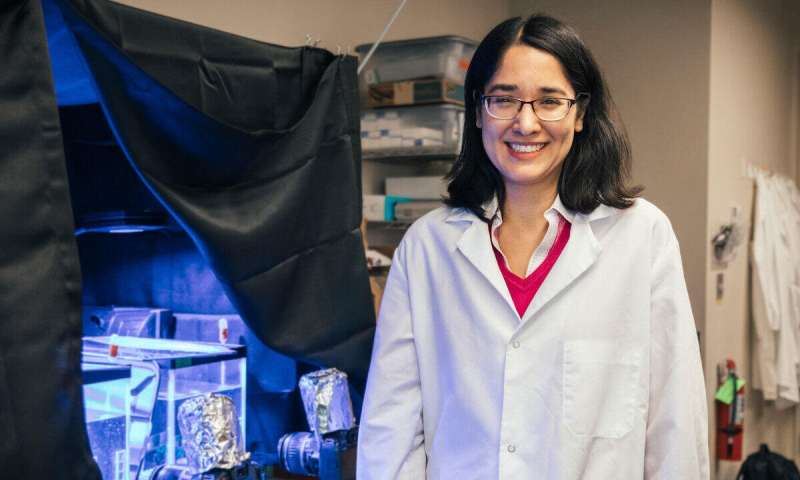
Coral reefs—the foundation of many aquatic ecosystems—are among the ocean’s most vulnerable inhabitants. While natural processes, like animal predation and storms, frequently damage corals, human impact, like ship collisions and global warming, can destabilize these environments beyond their ability to recover.
To aid their restoration, Nastassja Lewinski, Ph.D., associate professor of chemical and life science engineering in Virginia Commonwealth University’s College of Engineering, is among the researchers working to understand how corals heal. They also seek partnerships that can support coral preservation by applying this research to industry practices and funding continued research.
“Coral ecosystems are vital to human life,” Lewinski said. “When there’s a high-intensity storm, reefs can absorb the impact and reduce the damage we see on land. They’re also important to the aquatic food web and serve as the foundation to many foods we eat.”
Discovering the limits of coral healing is part of Lewinski’s work. Ideal water temperature for coral is 25°C, so research is conducted at that mark as well as at elevated conditions of 28°C to 31°C, the projected water temperatures influenced by global warming. Successive imaging of coral wound closure in these conditions builds an understanding of the rate of closure during healing.
“We’re looking to understand the mechanics of healing,” Lewinski said. “Some of what we’ve found suggests a process similar to human healing. We want to understand the actors in this process at a cellular level and what their role is in repairing tissue.”
These observations inform the mathematical, cell-based wound-healing model developed by Lewinski’s VCU collaborators: associate professor Angela Reynolds, Ph.D., and professor and interim chair Rebecca Segal, Ph.D., both in the Department of Mathematics and Applied Mathematics in VCU’s College of Humanities and Sciences.
Similar to humans, corals have been documented as following the same four stages of the healing process: 1) coagulation to close the site of injury, 2) infiltration with immune cells to ward off infection, 3) cell migration and proliferation, and 4) scar remodeling.
“With our observations and a mathematical model, the next step is to collect data on the cellular dynamics of the healing process,” Lewinski said. “We want to observe what kinds of cells enter the wound area and what functions they perform during healing.”
Fluorescent tagging is used to mark specific cells so they may be observed entering the wound area when healing occurs. Because corals are naturally fluorescent, the selection of the fluorescent tags must take this into account. Phagocytic properties allow immune cells to engulf and absorb bacteria and other small cells—in this case, the fluorescent particles being used to tag immune cells.
Nutritional variables also are being considered within the experiment. Corals derive energy from consuming small organisms and from their symbiotic relationship with algae colonies. Modifying nutritional balance in the lab emulates a coral’s participation in the food web, where accessibility to vital nutrients could impact healing.
Developing a nanoparticle drug-delivery system designed to dispatch molecules to speed wound healing is the culmination of this research. Lewinski hypothesizes the delivery system would promote an energy-burning state within the corals that could result in increased healing. This is among a few examples of harnessing nanotechnology for safeguarding coral reefs, which are discussed in a recently published comment authored by Lewinski and colleagues in Nature Nanotechnology.
“The research we’re doing on wound healing in corals is the start of something bigger,” Lewinski said. “Our goal is to create a center dedicated to engineering new technologies for corals. We want to find partners who can translate our research findings to practice, helping preserve coral reefs and the vital resources they provide.”
Through this consortium, newly developed science could be disseminated more effectively within each partner’s respective industry. The result: a renewed commitment to aquatic sustainability and the protection of vital coral ecosystems.
More information:
Liza Roger et al, Nanotechnology for coral reef conservation, restoration and rehabilitation, Nature Nanotechnology (2023). DOI: 10.1038/s41565-023-01402-6
Provided by
Virginia Commonwealth University
Citation:
Like humans, coral reefs have a healing process. Researchers are working to understand it (2023, July 14)
retrieved 15 July 2023
from https://phys.org/news/2023-07-humans-coral-reefs.html
This document is subject to copyright. Apart from any fair dealing for the purpose of private study or research, no
part may be reproduced without the written permission. The content is provided for information purposes only.









